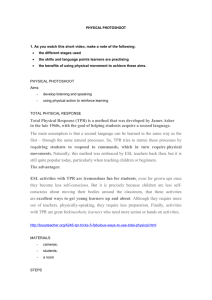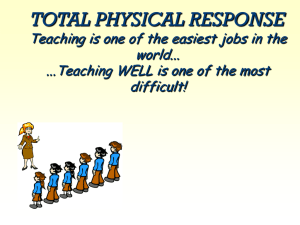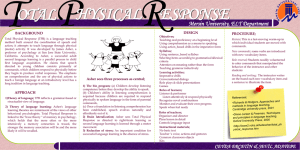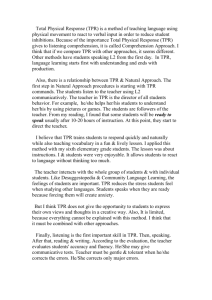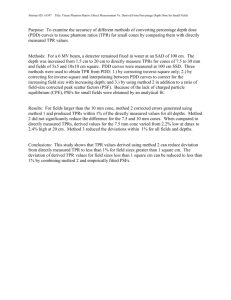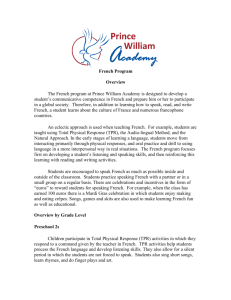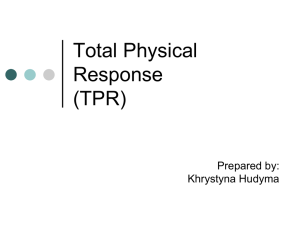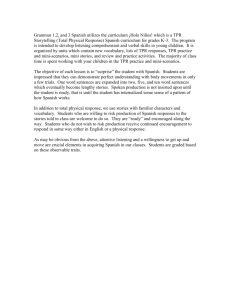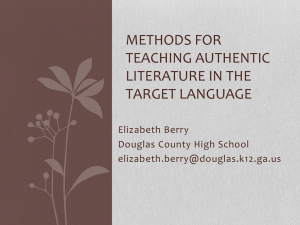TEACHING READING USING TOTAL PHYSICAL RESPONSE
advertisement
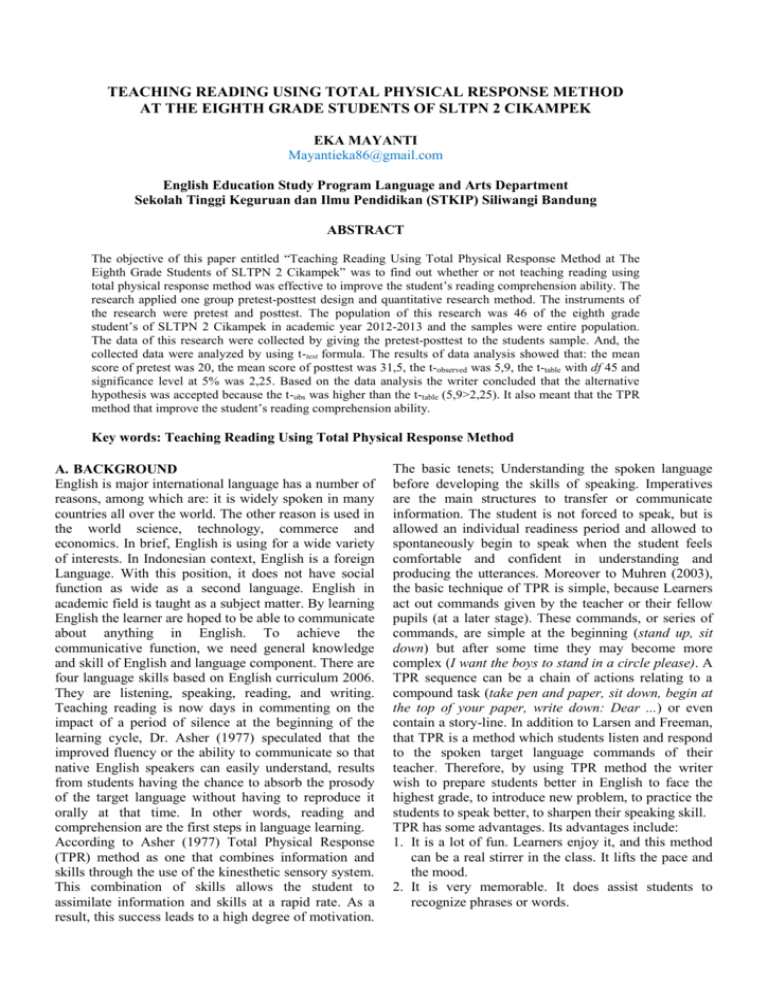
TEACHING READING USING TOTAL PHYSICAL RESPONSE METHOD AT THE EIGHTH GRADE STUDENTS OF SLTPN 2 CIKAMPEK EKA MAYANTI Mayantieka86@gmail.com English Education Study Program Language and Arts Department Sekolah Tinggi Keguruan dan Ilmu Pendidikan (STKIP) Siliwangi Bandung ABSTRACT The objective of this paper entitled “Teaching Reading Using Total Physical Response Method at The Eighth Grade Students of SLTPN 2 Cikampek” was to find out whether or not teaching reading using total physical response method was effective to improve the student’s reading comprehension ability. The research applied one group pretest-posttest design and quantitative research method. The instruments of the research were pretest and posttest. The population of this research was 46 of the eighth grade student’s of SLTPN 2 Cikampek in academic year 2012-2013 and the samples were entire population. The data of this research were collected by giving the pretest-posttest to the students sample. And, the collected data were analyzed by using t-test formula. The results of data analysis showed that: the mean score of pretest was 20, the mean score of posttest was 31,5, the t-observed was 5,9, the t-table with df 45 and significance level at 5% was 2,25. Based on the data analysis the writer concluded that the alternative hypothesis was accepted because the t-obs was higher than the t-table (5,9>2,25). It also meant that the TPR method that improve the student’s reading comprehension ability. Key words: Teaching Reading Using Total Physical Response Method A. BACKGROUND English is major international language has a number of reasons, among which are: it is widely spoken in many countries all over the world. The other reason is used in the world science, technology, commerce and economics. In brief, English is using for a wide variety of interests. In Indonesian context, English is a foreign Language. With this position, it does not have social function as wide as a second language. English in academic field is taught as a subject matter. By learning English the learner are hoped to be able to communicate about anything in English. To achieve the communicative function, we need general knowledge and skill of English and language component. There are four language skills based on English curriculum 2006. They are listening, speaking, reading, and writing. Teaching reading is now days in commenting on the impact of a period of silence at the beginning of the learning cycle, Dr. Asher (1977) speculated that the improved fluency or the ability to communicate so that native English speakers can easily understand, results from students having the chance to absorb the prosody of the target language without having to reproduce it orally at that time. In other words, reading and comprehension are the first steps in language learning. According to Asher (1977) Total Physical Response (TPR) method as one that combines information and skills through the use of the kinesthetic sensory system. This combination of skills allows the student to assimilate information and skills at a rapid rate. As a result, this success leads to a high degree of motivation. The basic tenets; Understanding the spoken language before developing the skills of speaking. Imperatives are the main structures to transfer or communicate information. The student is not forced to speak, but is allowed an individual readiness period and allowed to spontaneously begin to speak when the student feels comfortable and confident in understanding and producing the utterances. Moreover to Muhren (2003), the basic technique of TPR is simple, because Learners act out commands given by the teacher or their fellow pupils (at a later stage). These commands, or series of commands, are simple at the beginning (stand up, sit down) but after some time they may become more complex (I want the boys to stand in a circle please). A TPR sequence can be a chain of actions relating to a compound task (take pen and paper, sit down, begin at the top of your paper, write down: Dear ...) or even contain a story-line. In addition to Larsen and Freeman, that TPR is a method which students listen and respond to the spoken target language commands of their teacher. Therefore, by using TPR method the writer wish to prepare students better in English to face the highest grade, to introduce new problem, to practice the students to speak better, to sharpen their speaking skill. TPR has some advantages. Its advantages include: 1. It is a lot of fun. Learners enjoy it, and this method can be a real stirrer in the class. It lifts the pace and the mood. 2. It is very memorable. It does assist students to recognize phrases or words. 3. It is good for students learners who are required to be active in the Class. 4. It can be used both in large or small classes. In this case, it is no matter to have how many students you have as long as you are prepared to take the lead, the learners will follow. 5. It works well with mixed-ability classes. The physical actions get across the meaning effectively so that all the learners are able to comprehend and apply the target language. 6. It is no need to have a lot of preparation or materials using the TPR. 7. It is very effective with teenagers and young learners, and 8. It involves both left and right-brained learning; Teaching of English for Children has been of particular concerns. For this reason, there are some characteristics of young learners presented by Scott and Lisbeth (1992), that children particularly aged 8-10 are competent mother tongue users they are aware of basic linguistic rules of their mother tongue. At these ages, children can grasp abstracts and symbols, generalize language, and systematize it. Children are also capable of interpreting meaning without understanding words separately, are competent in using language creatively, are frequently fond of doing exploration and making a certain condition enjoyable; have established imagination; and are fond of communicating (Halliwell, 1992). Considering the benefits of TPR, results of this study can help students improve their reading comprehension. The result would be applied on the 8thgrade students of SLTPN 2 Cikampek. B. LITERATURE REVIEW 1. Definition of Teaching Herrel and Jordan (2004:6) claims , teaching is give instruction or give skills in a classroom, surely with the materials and uses the approaches, the methods, the strategies and the techniques for creating the classroom effectively. Teaching is sequences of activities which have the goal, and it is planned well. 2. The Total Physical Response Method Total Physical Response (TPR) is one of new methods developed by James Asher, a professor of psychology at San José State University, California, USA, to aid learning foreign language. TPR is a language learning method which is based on the coordination of speech and action. It is linked to the trace theory of memory, which holds that the more often or intensively a memory connection is traced, the stronger memory will be. In TPR classroom, students respond to commands that require physical movement. Asher defines that the method of TPR relies on the assumption that when learning a second language or a foreign language, that language is internalized through a process that is similar to first language development and that the processallows for long period of listening and developing comprehension prior to production (www.wikipedia.com), Richard and Rodgers (1986:87) state that TPR is a language teaching methodbuilt around the coordination of speech and action; it attempts to teach languagethrough physical (motor) activity. Garcia (2001:1) explains that the two very important concepts in TPR are thenotion of Total Physical Response involvement and the role played by the righthemisphere of the brain in learning a second language by action.The first concept deals with the idea of introducing second language by givingaction response which has been influenced by the way people acquire their firstlanguage. A baby would not memorize a list of words or try to speak immediately.They just listen first to the other family members and then act or do thing in response to their utterances. In the next period he would speak if he was ready to. Nevertheless at first, he would listen and carry out actions or respond physically to him. The second one relates to the brain hemisphere. Our brain is divided into two parts, left and right hemispheres. Scientists had found that the left and the right hemisphere were two independent neurogical entities having different functions both account for different responsibilities (Garcia, 2001:1), Garcia explains further that the TPR approach is a right brain method of learning a language because the language is taught mainly through actions. In theother words, commands play as the core of the course. TPR is based on the premise that the human brain has a biological programfrom acquiring any natural language in the world including the sign language of the deaf. The process is visible when we observe how infants internalize their first language (www.tprsource.com/asher.htm). Asher looks to the way that childrencombine both verbal and physical aspects. A child responds physically to the speechfor the parent. The responses of the child are in turn positively reinforced by thespeech of the parent. For many months the child absorbs the language without being able to speak. With TPR the teacher tries to mimic this process in class (www.tprworld.com/organizing). TPR is also named the comprehension approach since of the importance given to listening comprehension. In TPR, students listen and respond to the spoken targetlanguage commands of their teacher. If they can perform the teacher’s instructions it means that they know the meaning of the words. From the explanation above, the writer concludes that TPR places more emphasis on the link between word and action. The activity, where a command is given in the imperative and the learners obey the command, is the main activity of TPR. Therefore, it will be easier for the students to recall the words they have learned if they use their body in learning vocabulary items. The powerful method of TPR is best applied to introduce new vocabulary and new grammatical feature at any level.TPR can be varied in any different activities such as storytelling, dialogue, games, or a pattern drill. A method or technique in teaching and learning process must be developed inorder to get a better purpose for a better life. TPR was developed in order to improvethe better result of teaching learning process of a new language. Teachers who useTPR believe in the importance of having the students enjoy their experience inlearning to communicate a foreign language. According to LarsenFreeman (2000:113), TPR was develop in order toreduce the stress people feel when studying foreign languages and thereby encouragestudents to persist in their study beyond a beginning level of proficiency. Richard and Rodgers (1986:91) say:“The general objectives of Total Physical Response are to teach oralproficiency at a beginning level. Comprehension is a mean to an end, and theultimate aim is to give basic speaking skills. TPR aims to produce learnerswho are capable of an uninhibited communication that is intelligible to anative speaker”. From the statement above, there are some objectives of TPR : 1) Teaching oral proficiency at a beginning level. 2) Using comprehension as a means to reading. 3) Using action-based drills in the imperative form. D. FINDING AND DISCUSSION 1, Research finding No 1 2 3 4 5 6 7 8 9 10 11 12 13 14 15 16 17 18 19 20 21 22 23 24 25 26 27 28 29 30 31 32 33 34 35 36 37 38 39 40 C. RESEARCH METHODOLOGY 41 42 43 1. Research Method This is a quantitative research, which relies data based on computation and measurement. “Quantitative research methods are used to examine questions that can be answered by collecting statistically analyzing data that are in numerical form.”(Crowl, 1996:10). The data measured are in the form of numbers. 44 45 46 Student Student Student Student Student Student Student Student Student Student Student Student Student Student Student Student Student Student Student Student Student Student Student Student Student Student Student Student Student Student Student Student Student Student Student Student Student Student Student Student Student Student Student Student Student Student Student X Y 22 20 25 23 22 18 25 22 22 19 24 20 22 20 24 20 25 22 24 20 24 19 22 20 27 22 23 22 23 21 26 23 25 22 22 19 22 19 25 21 21 20 25 20 22 20 24 19 22 18 27 22 24 20 23 21 23 18 24 21 22 19 25 21 21 18 21 19 24 20 23 20 22 19 25 22 24 19 25 24 24 22 21 18 22 19 21 18 21 17 27 23 929,00 1.077,00 1 2 3 4 5 6 7 8 9 10 11 12 13 14 15 16 17 18 19 20 21 22 23 24 25 26 27 28 29 30 31 32 33 34 35 36 37 38 39 40 41 42 43 44 45 46 Total D = (X-Y) D2 = (X-Y)2 -2 4 -2 4 -4 16 -3 9 -3 9 -4 16 -2 4 -4 16 -3 9 -4 16 -5 25 -2 4 -5 25 -1 1 -2 4 -3 9 -3 9 -3 9 -3 9 -4 16 -1 1 -5 25 -2 4 -5 25 -4 16 -5 25 -4 16 -2 4 -5 25 -3 9 -3 9 -4 16 -3 9 -2 4 -4 16 -3 9 -3 9 -3 9 -5 25 -1 1 -2 4 -3 9 -3 9 -3 9 -4 16 -4 16 -148,00 534,00 Based on the data in table 9, the researcher calculated the result of ∑D = -126 and ∑D 2 = 670. Then, she tried to find out the standard deviation of differences (SDD) with the formula: SD D SD D D 2 N D N 1077 148 46 46 SD D 23,41 - 3,2 SD D 23,41 10,24 SD D 13,17 SD D 3,62 2 2 2 To find out the mean of differences (MD) between variable X and Y, the researcher used the formula: D N 148 MD 46 MD -3,2 MD After gaining the result of SDD = -3,2 the researcher calculated the standard error from mean of differences (SEMD) between variable X and Y : SDD N 1 SDD N 1 3,62 46 1 3,62 45 3,62 6,7 0,54 SE MD SE MD SE MD SE MD SE MD SE MD The last calculation is determining the result of t observation (to) of the test with formula: to MD SE MD 3,2 0,54 to 5,9 to The result -5,9 indicated that there was a difference of degree as much as -5,9. Regardless the minus, it doesnít indicate negative score. Then, to complete the result of the research, the writer finds out the degree of freedom (df) with the formula: df N 1 df 46 1 df 45 df = 45 (see table of ìtî value at the degree of significance of 5% and 1%) At the degree of significance 5% = 2,25 At the degree of significance 1% = 0,45 The result is 2,25 <5,9> 0,45 The result of analyzing the data by using the above formula shows that the coefficient is 5,9 It means that there is a significance increase after the TPR is used to teach reading. E. CONCLUSIONS AND SUGGESTION 1. Conclusions Based on the data described above, the students reading comprehension ability, are obtains that the value of to is 1.00 the degree of freedom (df) is 45. In the table of the degree of significant of 5% and 1% the value of the degree of significant is 2,25 and 0,45. It means that Ho is rejected and Ha is accepted, and it can be concluded that a teaching reading is significaning comprehension ability. The writer also conclude that most students are still weak not only in their achievement of vocabulary, but also in reading comprehension ability. For example using dictionary is very helpful for them to find out the meaning of words. So, the teacher must give the students guidance and detil explanation for both of them. The students understand, and more carefull when they was been their reading test. It was made teaching reading using TPR can be reading comprehension ability. 2. Suggestion Based on the conclusion above, it is suggested that in reading ability are : 1. A teacher should know and able to implement a good method in teaching reading, because it is quite complicated to learn. 2. English teacher is a motivator and stimulator. The teacher should support the students’ expectation about reading and arouse their interest to increase their reading comprehension. 3. The teacher should encourage the students to have and use dictionary as a too help them with difficult words. 4. The teacher should also give a high motivation to the students to read more and more English literature to increase their reading comprehension ability. 5. A teacher should also give guidance for students who get bad score and give the students interesting method to make the students more interesting in learning english, especially in reading comprehension. BIBLIOGRAPHY Arikunto, S. (2006). Dasar-dasar Evaluasi Pendidikan. Jakarta: Bumi Aksara. Asher, J. James. The Total Physical Response Approach To Learning Language. www.tprworld.com/organizing.htm Brown, D. (2001). Teaching by principles (second edition). San Francisco State University: Longman Publishers, Inc. Crowl, Thomas. (1996). Fundamentals of Educational Research. Dubuque: Brown & Benchmark Publisher. Harmer, Jeremy. (2001). The Practice of English Language Teaching. New York: Longman. Hornby, AS.(1995). Oxford Advanced Learner’s Dictionary. New York: Oxford University Press. Larsen-Freeman, Diane. (2000). Technique and Principles in Language Teaching (Second Edition). New York: Oxford University Press. Richard, J and Renandya, W. (2002). Methodology in Language Teaching (An Antology of Current Practice. Cambridge University: Cambridge University Press. Richards, Theodore. (1999). Approaches and Method in Language Teaching. New York: Oxford University Press. Yoosabai, Y. (2009). Teaching English Reading Comprehension In A Thai High-School Classroom. Dissertation. Available at hhtp:/www.eric.ed.go. Accesed on 14 January 2011.
